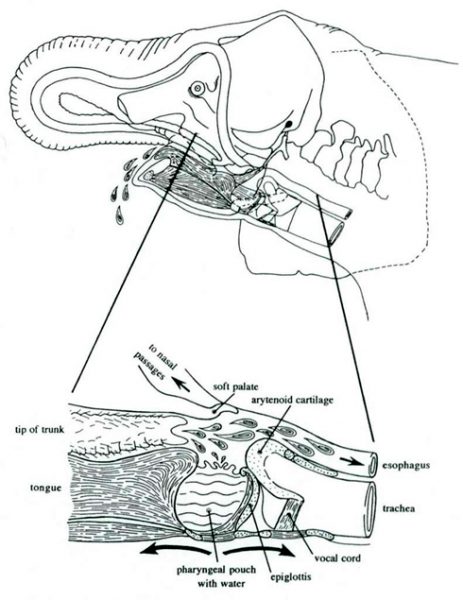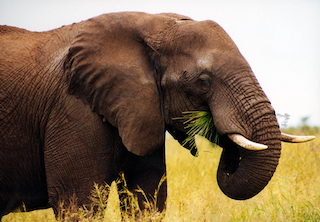The Elephant’s Trunk And Its Uses
The trunk of the elephant is one of the body parts to have evolved among mammals. It is unique to members of the Proboscidea, which includes the extinct mammoths and mastodons. The trunk weighs 130 kg and is capable of lifting about 250 kg. It is also extremely dexterous, sensitive, and mobile, which makes it appear independent of the rest of the body. It is put to use for various purposes.
Anatomy of trunk
Anatomically, an elephant’s trunk is a combination of the nose and upper lip. The nostrils are at the tip. The proboscis comprises of 16 muscles. The most significant muscle, which covers the top and the sides, raises the trunk. Another muscle covers the bottom. Inside the trunk is a complex network of transverse and radiating muscle fascicles that supports the elephant with its movement. The trunk is innervated by two nerves, which render it sensitive. The bifurcations of these nerves reach most portions of the trunk. It especially reaches the tip, which has tactile bristles at regular intervals.
Functions of trunk
The end has flap-like projections enabling it to perform delicate functions, such as cracking a peanut open, picking up a coin from a surface that is flat, putting the kernel in the mouth, and blowing away the shell. They similarly gather objects in a manner that humans use the thumb and index finger. Elephants use the trunk in other ways as well. They involve holding branches as well as scratching themselves in places that the tail cannot reach. It is also used to collect grass or dust for spraying onto themselves, for protection against the sun and insect bites. When elephants meet, they will intertwine trunks, or one may touch the other’s face. The trunk-shake is like a human handshake. It may be associated with functions such as greeting or assurance or as a way of estimating strength. If danger is near, elephants swivel the trunk, possibly sniffing the air.
Consuming with trunk
For a long time, field researchers have observed a particular tool-making behavior of elephants. They use its trunk and tusks to strip bark from trees and chew it to make a giant ball. Then they plug a waterhole previously dug and covers it with sand. When they need water, they uncover the sand and unplug the hole. And they drink the water from the hole. They drink by sucking water through the trunk and squirting it into the mouth. While eating, they detach fruits, leaves, and grasses and place them into the mouth. Per day, an elephant can consume food of up to 100 kg and 100 liters of water or even more for a thirsty and hungry individual. Such consumption makes them an important ecological factor as they substantially affect the ecosystems.
Sets of teeth
Elephants have six sets of teeth in their lifetime. They do not erupt at once. At birth, it has two or three pairs of teeth in each jaw. New ones develop from behind and move forward as worn teeth either fall out. Each new set is heavier, longer, and wider. The last teeth can measure 40 cm long and weigh up to 5 kg. Only the remains of the last four molars are present after 60 years of age. Tooth loss brings on starvation and sometimes can be the cause of death.
Types of vocalization
Elephants produce sounds by modifying the nostril size as air is passed through. Quiet sounds are the roar, rolling growl and snort; high sounds are the trumpet, trump, pulsated trumpet, gruff cry, trumpet phrase and bark. Rumbling sounds thought to be caused by the intestines are produced by the voice box. They are considered to be similar to cats purring. They can also create other sounds by beating the trunk against their tusks, a tree, or even on hard ground.
Origin of sounds
Vocalizations originate in the larynx as well as a structure associated with it called the pharyngeal pouch. In the other mammals, there are nine bones in the throat connected in a boxlike configuration known as the hyoid structure, which supports the voice box and the tongue. But the hyoid fabric of the elephants has only five bones. Muscles, ligaments, and tendons fill the gap between the bones. These attachments allow the larynx a degree of freedom enabling the pharyngeal pouch to form just behind the tongue.
The structure facilitates sound production and has muscles that function as a resonating chamber for sounds emitted at frequencies that cannot be heard by human beings. But other elephants who are up to even 4 km away can respond to these low-frequency calls. Low-frequency waves of sound travel through the ground and air and experiments indicate that the animals can detect infrasonic sounds as seismic waves.
Puzzling pharyngeal pouch
Apart from the usual functions performed by the trunk of the elephants, there is another role that it plays. People have observed for centuries that in times when there is hardly any water nearby and on hot days, elephants put their trunks into their mouths, retrieve liquid, and spray themselves. But the source of this water has been a mystery.
Two credible sources of the water are the pharyngeal pouch and the stomach. The sprayed water contains small food particles and such content are found in the pharyngeal pouch and not in the stomach. The contents of the stomach are digested food, and that would irritate the skin because they are acidic. Moreover, elephants are seen doing the spraying even while walking and running. It would be difficult to suck water from the stomach and do the spraying while walking or running. Therefore, the most likely explanation for the water’s source is the pharyngeal pouch and not the stomach.
Studies about the mysterious phenomenon of elephants using the trunk to retrieve water from its body are inconclusive. Observations and research about it are still underway.
5 Frequently Asked Questions About Elephant Trunk
To receive a colourful digibook about elephant with videos, images and text, please fill out the following form or simply email us on safaris@safari-center.com







